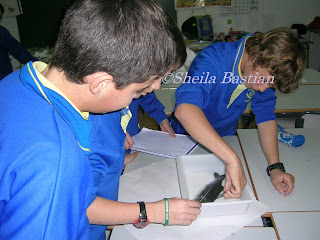Fish are aquatic vertebrates. They live in fresh or salt water. They are cold-blooded, that is, they cannot regulate their body temperature. They breathe through gills. They reproduce sexually. Fertilisation takes place externally. They are oviparous, however sharks are ovoviviparous, and fertilisation is internal. There are two goups of fish: cartilaginous, such as rays or sharks and bony, such as carp, salmon, sea bass, trout etc.
We have studied the external anatomy of a fish. We have had the opportunity to take a close look at some of the parts of the fish that we studied beforehand. The fish we used for the experiment were sea bass. We placed the fish on plastic trays and we used tweezers and magnifying glasses. We have also learnt how to do a scientific diagram, which is a clearly labelled picture.
First we observed the
fusiform body of the fish, that is wider in the middle than at the ends.
 |
| A sea bass |
Fish limbs are called
fins. With the tweezers we opened and looked at the shape of the fins. We saw that the fins are made up of spines and skin.
 |
| Dorsal fin.. |
Fish can have upto three
dorsal fins. We saw that sea bass have two.
 |
| Pelvic fin. |
 |
| Anal fin |
 |
| Caudal fin |
 |
| Lateral fin |
With the tweezers we felt the
operculum and noticed that it is made up of hard tissue. It protects the gills. (Sharks and rays have no operculum).
Behind the operculum we saw the
gills. The gills are the respiratory organ. They are used to extract oygen from the water and release carbon dioxide. We noticed that the gills are made of highly folded tissue and are full of blood, covered with a very thin layer of tissue. We could tell because of the red colour of the gills. Both characteristics are typical of respiratory organs, the folded tissue increases the surface area so more oxygen can be trapped and the thin tissue helps the oxygen penetrate easily into the blood.
 |
| Gill |
We put the tweezers in through the gills to see how they are connected to the mouth. Fish take in water through the mouth and it goes out through the gills. As it passes the blood traps the oxygen from the water.
We opened the mouth to see the
tongue and the tiny
teeth.
We also observed the
scales and the
lateral line. The lateral line is a sensory organ, it is full of receptors that detect vibrations.
Here are some great scientific diagrams of the fish we studied.
 |
| By Rodrigo Contreras - E1C |
 |
| By Cristina Romero - E1B |
 |
| By Elena Pérez - E1B |
 |
| By Inaki Antequera - E1C |
 |
| By Ana Ortiz - E1C |
 |
| By María Muñoz - E1C |
 |
| By Juan de Agustín - E1B |
 |
| By Julia Compañó - E1D |
 |
| By Carmen González - E1D |
 |
| By Alejandra Sánchez - E1D |
Did you enjoy this experiment? Leave your comment!
























